12 November, 2004
Over the sound to Lake Hoare we go!
Temperature: 12 * F and blustery!
Location: McMurdo Station and Lake Hoare
We thought our flight to the Dry Valleys may actually get canceled today due to
the heavy winds. But, in true Antarctica fashion, the weather changed within
an hour, and we loaded up and flew to the valleys! At times, the helicopter
swayed from side to side; almost like we were “fishtailing”. I felt like we
were in a toy helicopter being “flown” around in the hands of a child. It was
never dangerous or frightening, just a bit exciting! It was a beautiful ride
over McMurdo Sound, and a stunning trip up the valley.
Through the helicopter window, we could see the various valley glaciers seeping
into the barren basin of Taylor Valley. We flew over Lake Fryxell where we
could clearly see the “moats” around the lake. The lakes in this valley are
frozen for most of the year, but each summer the edges of the lakes melt,
creating a moat. The moat ice is smoother than the rest of the lake, thus
there is a definite delineation between the two regions.
We landed at Lake Hoare and quickly set up camp. We spent a few moments
appreciating the splendor of the Canada Glacier. We could hear the aerie
groans and pops from within the glacier as it attempts to push it’s way
forward. There are sections of the glacier where quite large sheets of ice
have calved off the terminal wall. We questioned how many terrestrial glaciers
“calve” like the glaciers that flow into water.
After a brief interlude with the glacier, we got right to work. We loaded up
the ATV and headed out onto the lake to start making the dive hole. It will
take a couple days to melt a hole large enough to allow divers safe access to
the waters below the lake.
To make the hole, we first had to drill a hole into the ice. The goal was for
the hole to go deep enough to almost “punch through” the ice. Once the hole
was drilled, we would put a hot finger (heating coil) down the hole to start
the melting process. That’s all fine in theory. We drilled as planned, but
the ice was just a bit thinner than we thought in the area we were drilling.
When using the drills, we must occasionally “clear” the hole. Clearing the
hole means to quickly raise the drill up and down the hole in order to bring up
the loose ice/snow that falls into the hole as we drill. Everything was going
along quite easily; a sure sign to keep on guard for something unexpected to
happen. Just when we thought this was the easiest hole to drill any of us had
experienced, we punched through the ice into the water. The cold lake water
immediately filled the hole. The cold lake water quickly turned the
“un-cleared” ice/snow in the hole to a sticky glue; almost a cement! We were
in a jam. We scrambled to get the drill augers out of the icy water before
they froze solid. We made some progress, but the lake was winning. We needed
more leverage, so we put a screw driver through a hole in the auger, then
placed a chisel handle over the screw driver. It worked like a charm. We were
almost free, when the screw driver shattered! We collected all the pieces and
then started over.
We drilled another hole beside the “stuck” auger. We are now melting the hole,
so the auger will be freed as the hole gets larger. We also had to tie the
stuck auger to the generator so that when the ice around it releases its grip,
the auger doesn’t fall into the lake. We will monitor the melt progress
through the night.
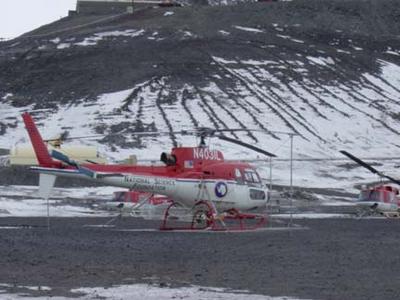
1. Helicopter on the pad with the rotors secured against the wind!
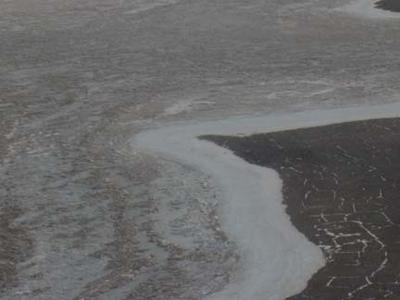
2. The edge of Lake Fryxell with the still frozen "moat" edge.
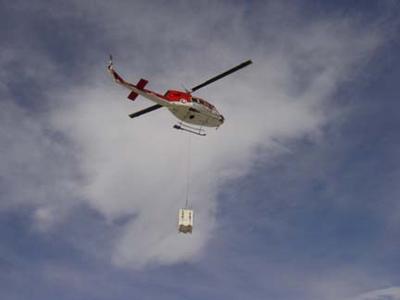
3. Helicopter bringing in one of our sling loads.
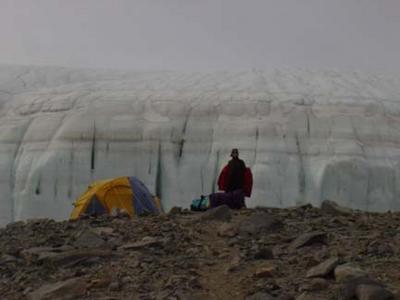
4. Jackie sets up her tent in front of the Canada Glacier!
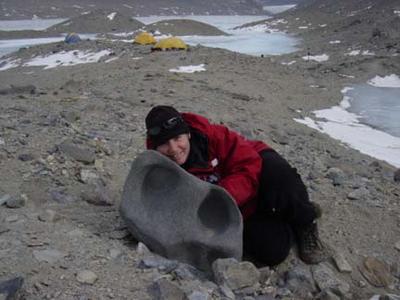
5. Me with a ventifact that is located right outside my tent!

6. Me within the ice fall of the Canada Glacier.
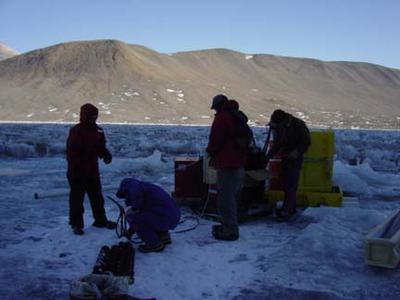
7. Peter, Brandy, Jackie, and Ian with the hole melting equipment.

8. The "busted" screw driver!
Contact the TEA in the field at
.
If you cannot connect through your browser, copy the
TEA's e-mail address in the "To:" line of
your favorite e-mail package.
|
